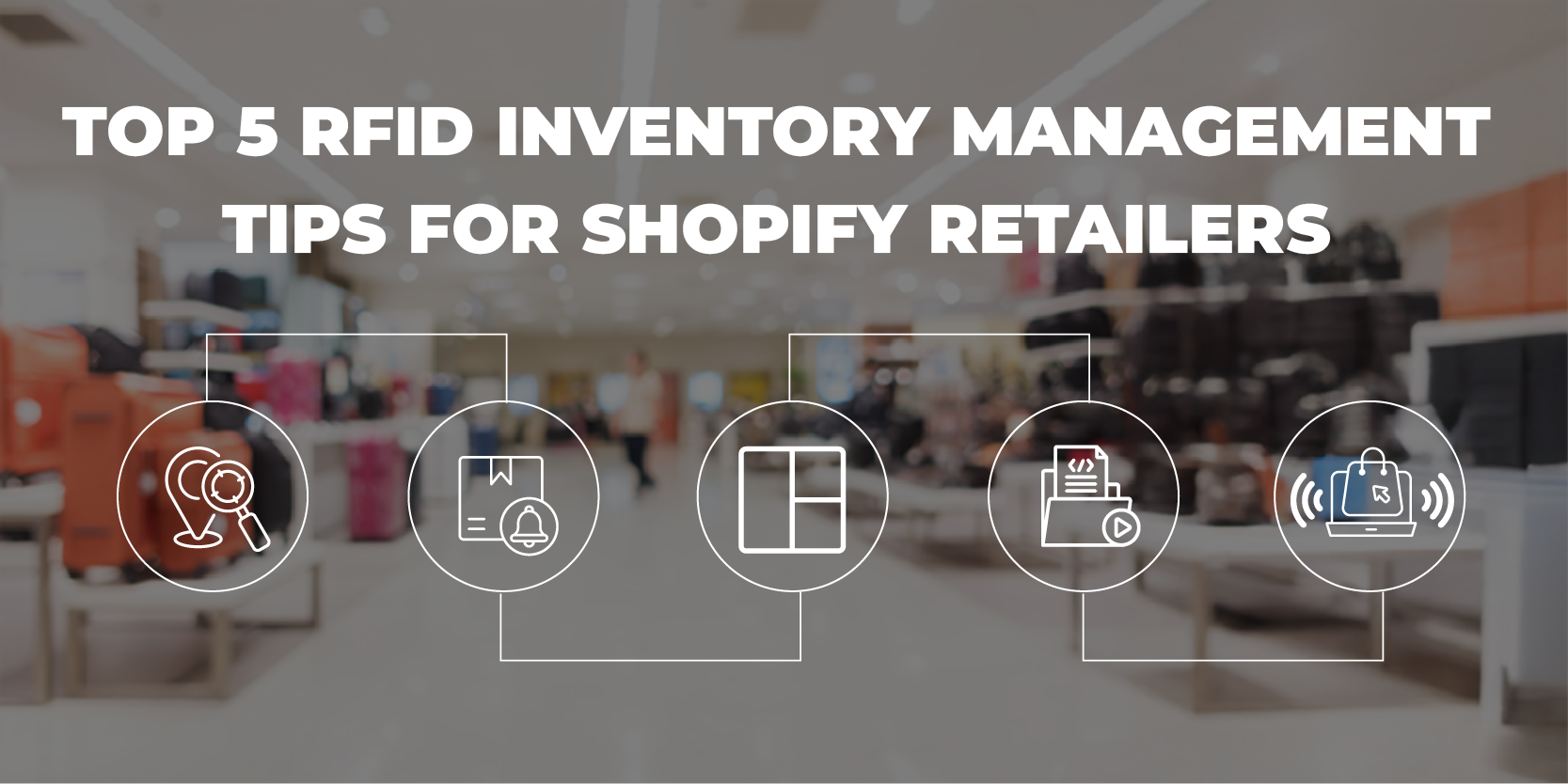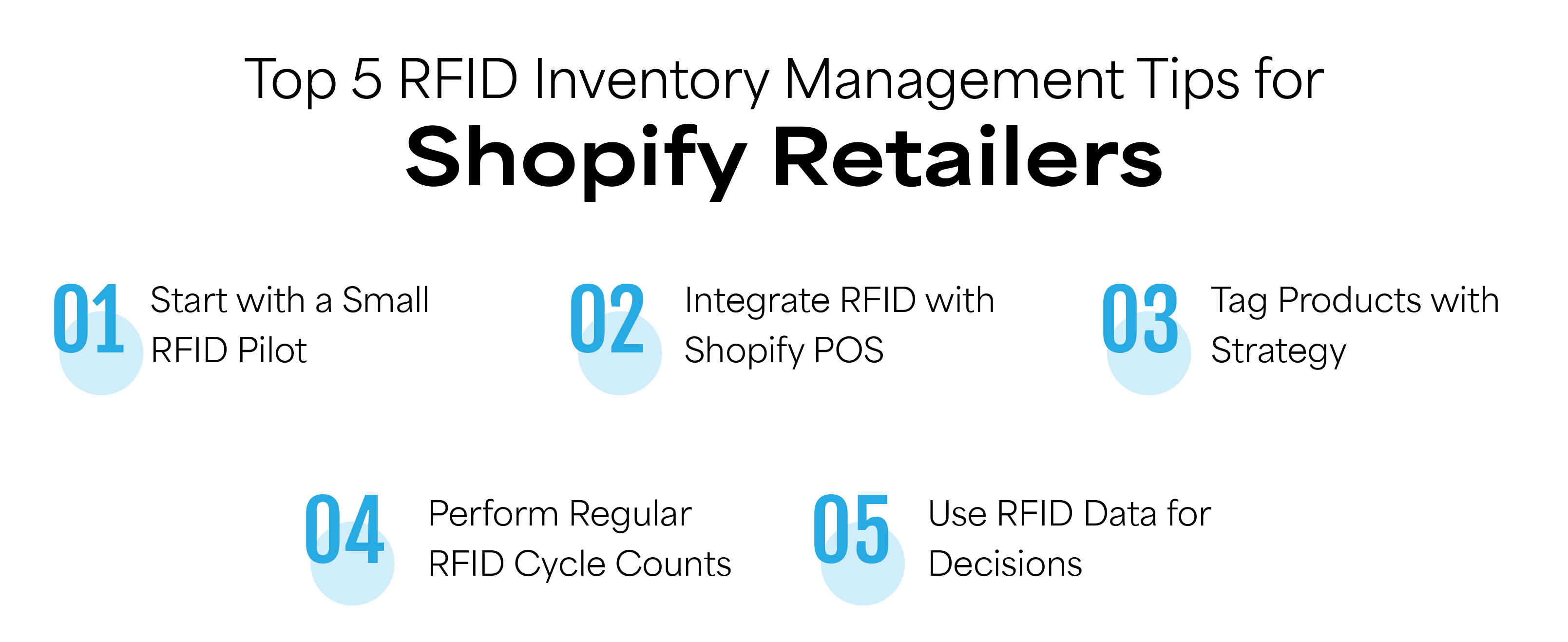Top 5 RFID Inventory Management Tips for Shopify retailers
Managing inventory manually or relying solely on barcodes can lead to costly errors, such as stock mismatches, overselling, and inefficient workflows. Accuracy and visibility are key for Shopify retailers looking to scale and operate across online and offline channels.

Radio Frequency Identification technology offers a powerful solution to streamline inventory tracking, reduce human error, and improve efficiency. This blog shares the top 5 RFID inventory tips tailored specifically for Shopify retailers who want to stay competitive, reduce inventory chaos, and boost profitability.
1: Start with a Small RFID Pilot Program
Before rolling out RFID across your entire inventory, begin with a small pilot program. Choose a limited set of SKUs or test the solution in a single store location. This allows you to:
- Evaluate the compatibility of RFID hardware and software with your existing Shopify systems.
- Identify training needs for staff who will handle tagging, scanning, and inventory tracking.
- Discover early challenges and fine-tune processes before a broader implementation.
- A pilot helps ensure that your RFID integration meets expectations and is cost-effective before full-scale deployment.
2: Integrate RFID with Your Shopify Storefront and POS
One of the biggest advantages of RFID is its ability to provide real-time inventory data. By integrating your RFID system with Shopify and your Point-of-Sale (POS), you can:
- Automatically update stock levels when items are sold or received.
- Reduce overselling and stockouts during peak seasons.
- Enable faster and more accurate order fulfillment for BOPIS (Buy Online, Pick Up In Store) or curbside pickups.
Using a solution like TagMatiks Retail Connect makes this integration seamless. It keeps your physical and digital inventories synchronized, improving accuracy and customer satisfaction.

3: Tag Products Strategically
Strategic tagging is one of the most important steps for successful RFID inventory management. As a Shopify retailer, you sell different kinds of products—clothing, electronics, accessories, or even items with metal packaging. Each category requires a specific type of RFID tag to ensure accurate reads and long-term performance.
Apparel: For clothing, retailers can use TronRFID paper RFID labels that are ideal for attaching. Options like the TronRFID 102 × 25 mm TT Paper RFID Label - Perforated, TronRFID 75 × 15 mm TT Paper RFID Label - No Perforation, TronRFID 101 × 50 mm TT Paper RFID Label - No Perforation, and TronRFID 43 × 19 mm TT Paper RFID Label - Perforated offer lightweight, non-intrusive solutions. These labels support efficient bulk scanning and maintain the visual appeal of the garment, making them perfect for retail apparel tagging.
Accessories and Electronics: Items like watches, phone cases, or small gadgets are best tagged with compact, durable RFID labels or hard tags. These are built to fit on small surfaces and handle frequent handling without falling off or getting damaged.
Products with Metal Surfaces: If you’re tagging items that contain or are packaged in metal—like power banks or beauty kits with foil elements, standard RFID tags might not work. In these cases, on-metal RFID tags are specially designed to prevent signal interference and deliver reliable reads even when attached to metal.
Tag Placement: It’s not just about what tag you use, but also where you place it. Tags should be applied in consistent locations across all similar products and positioned to avoid areas that may block the RFID signal (such as under thick layers or near metals or liquids). Correct placement improves scanning accuracy, especially during cycle counts or at checkout.
Pre-printed RFID Labels: For Shopify retailers managing a lot of SKUs, using pre-printed or pre-encoded RFID tags can save time and reduce errors. These labels arrive ready to apply, making in-store tagging quicker and more consistent across your team.
By selecting the right RFID tag and applying it correctly, you not only improve inventory accuracy but also set up your business for faster processes and better customer experiences.
4: Perform Regular Cycle Counts with RFID
One of RFID’s biggest advantages for Shopify retailers is how quickly it enables cycle counts. Instead of taking hours with manual or barcode methods, RFID-based counts can be completed in just minutes, even across large inventories. This speed allows you to perform more frequent counts, which helps detect stock discrepancies early and prevent losses from theft, misplacement, or human error.
Regular RFID cycle counting also ensures your Shopify store always reflects accurate stock levels, which is crucial for minimizing missed sales, backorders, and poor customer experiences. Especially in an omnichannel environment where online and in-store inventories must stay in sync, this level of precision becomes a major asset.
With a platform like TagMatiks Retail, Shopify businesses can automate and streamline their cycle counting workflows. The system allows staff to quickly scan large numbers of tagged items without line-of-sight, automatically reconcile stock levels, and generate audit trails for accountability. Whether you're managing a single boutique or a multi-location retail brand, TagMatiks Retail ensures you maintain high inventory accuracy with minimal effort.
5: Use RFID Data to Make Smarter Inventory Decisions
RFID systems generate detailed insights about inventory movement, dwell time, and usage patterns. Shopify retailers can use this data to:
- Identify bestsellers and slow-moving SKUs.
- Plan timely restocking and markdown strategies.
- Adjust product placement or marketing efforts based on real-world movement.
Some systems even offer heatmaps or traffic flow reports, helping you optimize store layout and customer experience.
Bonus Tip: Train Staff and Establish RFID Protocols
Even the most advanced RFID system won't deliver results without well-trained staff and clear operational protocols. It's essential to train your team on how to correctly apply and scan RFID tags, handle exceptions, and use both handheld and fixed RFID readers. Establishing Standard Operating Procedures (SOPs) for tasks like receiving, stocking, and shipping ensures that every team member follows a consistent workflow, reducing errors and maximizing the effectiveness of your RFID investment.
RFID Inventory Tracking System for Shopify Retailers
If you're looking for a proven RFID solution designed for Shopify, consider the TagMatiks Retail platform and TagMatiks RFID Connect:
TagMatiks Retail: A powerful RFID inventory management platform that handles everything from receiving to point-of-sale. It provides complete visibility of your inventory across all sales channels.
TagMatiks RFID Connect: Seamlessly connects your Shopify store with TagMatiks Retail. It keeps your online and physical inventory in sync, ensuring you never oversell or miss out on restocking opportunities.
This combination empowers Shopify retailers to manage inventory efficiently and scale operations with confidence.
Conclusion
Adopting RFID technology helps Shopify retailers move beyond outdated inventory methods. By starting with a pilot, integrating systems, tagging smartly, and leveraging real-time data, you can streamline operations, reduce losses, and grow profitably.
The future of retail is automated, connected, and data-driven. Embracing RFID today gives you a competitive edge in tomorrow’s marketplace.
Recent Posts
-
How RFID Antennas Function and Read RFID Tags and Labels
Introduction Radio Frequency Identification has become a cornerstone of modern tracking and automati …Jun 2nd 2025 -
Top 5 RFID Inventory Management Tips for Shopify retailers
Managing inventory manually or relying solely on barcodes can lead to costly errors, such as stock m …May 26th 2025 -
Which RFID Tags Work Best on Metal Surfaces
Introduction RFID technology has revolutionized asset tracking and inventory management. However, wh …May 19th 2025




